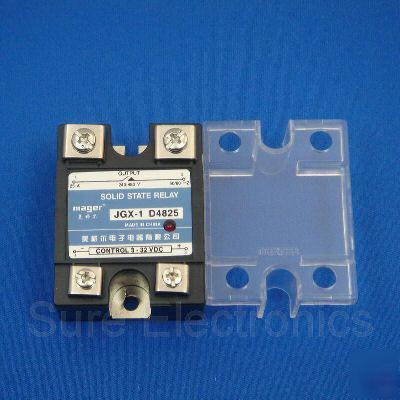Oak Bluffs, MA old classifieds archive and funnies > Funny Listings
> Very Funny
> Extremely Funny
> Solid state relays ssr 24-480V ac, 25A + heat sink
Solid state relays ssr 24-480V ac, 25A + heat sink
Solid State Relays SSR 24-480V AC, 25A + Heat Sink
A Solid State Relay (SSR) is an electronic switch that works without moving parts. They primarily consist of a low current control and a high current load, which are isolated optically or with transformers.
This Solid State Relay uses a DC3-20V signal to control AC24-480V load, input level could be TTL/CMOS input, and the drive current is less than 20mA. Load could be resistance type, and maximum current is less than 25A RMS. Load could not be DC type. Load could not be inductive type.
If SSR (DC-RR010 and DC-RR011) works without heat sink, the maximum continuous load current could never be over 3A.
If SSR (DC-RR010 and DC-RR011) works with DC-RR012 heat sink, the maximum continuous load current could be 5~10A.
If you want to use those SSRs with over 20A current, you should be careful that they should be installed on a very good heat sink, it is strongly suggested tha t you add an additional fan to enhance the air flow. Heat resistance must be less than 2.5℃/W. Over load and over heat will destroy the SSR.
This SSR can not work with an environmental temperature over 50 ℃.
If the load is inductive type, for example a motor or transformer, the rated current should be multiplied by 0.3-0.7, this factor equals to the load's power factor.
SSRs are commonly designed to use a photo-sensitive Silicon-Controlled Rectifier (SCR) device with a Light-Emitting Diode (LED) to actuate the device.
Solid State Relay (SSR): Light from the encapsulated LED actuates the photo-sensitive transistor and then the opto will drive the high current SCR, the SCR allows current to flow through it.
SSRs are a faster alternative to electromechanical relays because their switching time is dependent on the time required to power the LED on and off - approximately 1 ms and 0.5 ms respectively. Because there are no mechanical parts, their life expectancy is higher than an electromechanical relay.
SSRs are useful for high-voltage applications because the LED actuation provides a galvanic isolation barrier between the control circuitry and the SCR. Because the SCR is doing the switching, however, there is no galvanic barrier between its contacts. When there is no gate drive on the SCR, the drain-source channel on the SCR has a very high resistance providing the disconnection between the contacts.
Because the connection is made via a transistor instead of physical metal, as in electromechanical relays, the contact resistance for an SSR is greater. Although technology improvements are continually improving the contact resistance of SSRs, it is still not uncommon to find them in production today with resistances of 100 Ohms or more.
SSRs are not as robust as electromechanical relays. Much like reed relays, they are highly susceptible to surge currents and damage when used at signal levels above their rating. Although there are no metal contacts to weld, damage to the SCR can render the relay unusable.
Solid State Relays SSR 24-480V AC, 25A + Heat Sink
Solid State Relays SSR 24-480V AC, 25A SSR user's manual.pdf
Heat Sink for Solid State Relay (SSR) user's manual.pdf

